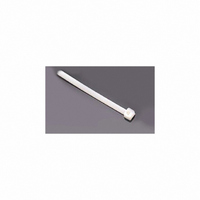PLT.7M-C Panduit Corp, PLT.7M-C Datasheet - Page 64

PLT.7M-C
Manufacturer Part Number
PLT.7M-C
Description
TIE CABLE PAN-TY 18LB 3.1"
Manufacturer
Panduit Corp
Series
PAN-TY®r
Type
Pan-Tyr
Specifications of PLT.7M-C
Wire/cable Tie Type
Standard, Locking
Bundle Diameter
0.68" (17.27mm)
Length
0.258' (78.74mm, 3.10")
Width
0.090" (2.30mm)
Mounting Type
Free Hanging (In-Line)
Tensile Strength
18 lbs. (8.2 kg)
Color
Natural
Cable Tie Length
3.1"
Cable Tie Width
0.09"
Body Material
Nylon 6.6
Tensile Strength Pounds
18lb
Cable Bundle Diameter Min
0.8mm
Cable Bundle Diameter Max
0.68"
Maximum Bundle Diameter
0.68 in
Product
Cable Ties
Application
For indoor use
Height
0.115" (Head)
Protection Class
Tie, Cable
Special Features
Locking
Operating Temp Range
-40C to 85C
Product Length (mm)
79mm
Product Depth (mm)
4.6mm
Product Height (mm)
2.9mm
Accessory Type
Locking Cable Tie
Rohs Compliant
Yes
Lead Free Status / RoHS Status
Lead free / RoHS Compliant
Features
-
Lead Free Status / Rohs Status
Lead free / RoHS Compliant
Other names
298-1018
64
Weathering
Weathering Test Methods
Outdoor Aging
Accelerated Weather Aging
Ultraviolet light (which is a component of sunlight) attacks, over a period of
time, most plastic materials and reduces their properties by breaking the
molecular chain. The material breakdown is accompanied by reductions in
tensile strength and elongation, increased brittleness, color changes and
loss of surface gloss.
Carbon black, which is used in PANDUIT
ties, is one of the most effective stabilizers known today. A uniform
dispersion of carbon black provides good ultraviolet light resistance without
adversely affecting physical properties. The addition of carbon black, or any
other ultraviolet light stabilizer, prolongs the useful life of plastic products
used outdoors, but it does not totally eliminate the destructive effects of the
light. Some plastics, such as TEFZEL** or HALAR*, are intrinsically very
resistant to ultraviolet light and do not require stabilizing additives.
In order to monitor the effects of ultraviolet light and the effectiveness of ultraviolet stabilizers, PANDUIT
in conformance with industry standards, adopted two methods of weatherability testing: Outdoor Aging and
Accelerated Weather Aging.
The Outdoor Aging method is probably the best and most realistic method of the two. It is conducted in
accordance with ASTM D1435 Standard Practice for Outdoor Weathering of Plastics, and allows the
material to be affected by not only ultraviolet light, but by all other outdoor elements as well. Although this
may more closely approximate an actual application, two drawbacks do exist. The period of time required
to produce property decay and material failure may be quite long, and varying adverse chemical
environments cannot be tested.
Accelerated weathering tests are conducted to estimate the rate of degradation due to a combination
of ultraviolet light, temperature and moisture. The methods used are in accordance with the
following standards:
• ASTM D1499, Operating Light and Water Exposure Apparatus (Carbon-Arc type) for exposure
• ASTM G53, Operating Light and Water Exposure (Fluorescent U.V. Condensation type) for exposure of
The condition specified in ASTM D1499 utilizes a carbon arc to simulate natural sunshine and a water
spray. The test chamber is operated 20 hrs/day with a two hour cycle of 108 minutes of simulated sunshine
and 12 minutes of sunshine and water spray. The temperature of a black body inside the chamber is
approximately 63°C (145°F) during the “Sunshine Only” portion of the cycle. Humidity is not controlled
inside the chamber.
The test chamber per ASTM G53 uses fluorescent sun lamps to generate ultraviolet light only. A heated
water pan produces condensation during a portion of the cycle.The daily cycle is composed of 20 hours of
light followed by 4 hours of condensation. Black body temperatures during the light cycle are 50°C (122°F)
PANDUIT
ultraviolet light on cable tie materials. The effect of other common chemicals, such as road salt, are also
evaluated in this chamber.
These methods are effective in quickly determining the ultraviolet light resistance of the various cable tie
materials, but it must be emphasized that there are no exact correlations between accelerated aging and
actual outdoor exposure.
and 40°C (104°F) during the condensation cycle.
to plastics
non-metallic materials
Most commonly used parts appear in BOLD.
®
has also designed a special chamber which is used to simulate the effect of acid rain and
Weathering
®
nylon and polypropylene cable
**TEFZEL is a registered trademark of E. I. DuPont de Nemours Co.
*HALAR is a registered trademark of Solvay Solexis, Inc.
®
,










